Financial Accounting Semester 2-2018: Sustainability Report Analysis
VerifiedAdded on 2023/06/07
|11
|2645
|385
Report
AI Summary
This report provides a critical review of four journal articles on sustainability reporting and evaluates BHP Billiton's 2017 sustainability report. The review of journal articles covers topics such as the examination of BHP's corporate social and environmental disclosures from 1983-1997 through the lens of legitimacy theory, the relationship between corporate governance and environmental reporting in Australian firms, the need for regulating corporate social responsibilities, and the role of legitimacy theory in environmental disclosures. The evaluation of BHP Billiton's sustainability report discusses the company's values, CEO's statement, sustainability framework, scope, stakeholders, and response to the Samarco dam failure, providing a comprehensive overview of the company's sustainability efforts and challenges during the reporting period.
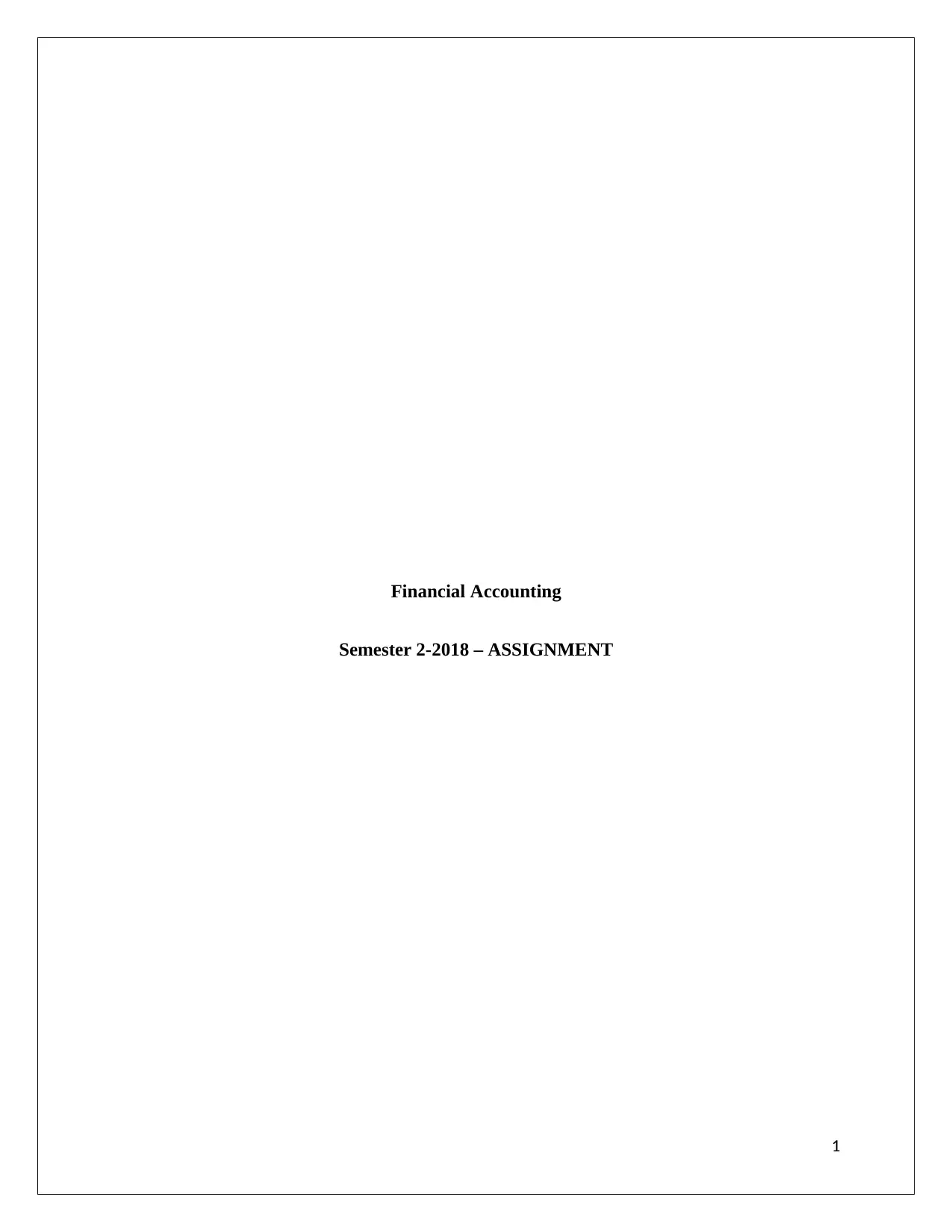
Financial Accounting
Semester 2-2018 – ASSIGNMENT
1
Semester 2-2018 – ASSIGNMENT
1
Paraphrase This Document
Need a fresh take? Get an instant paraphrase of this document with our AI Paraphraser
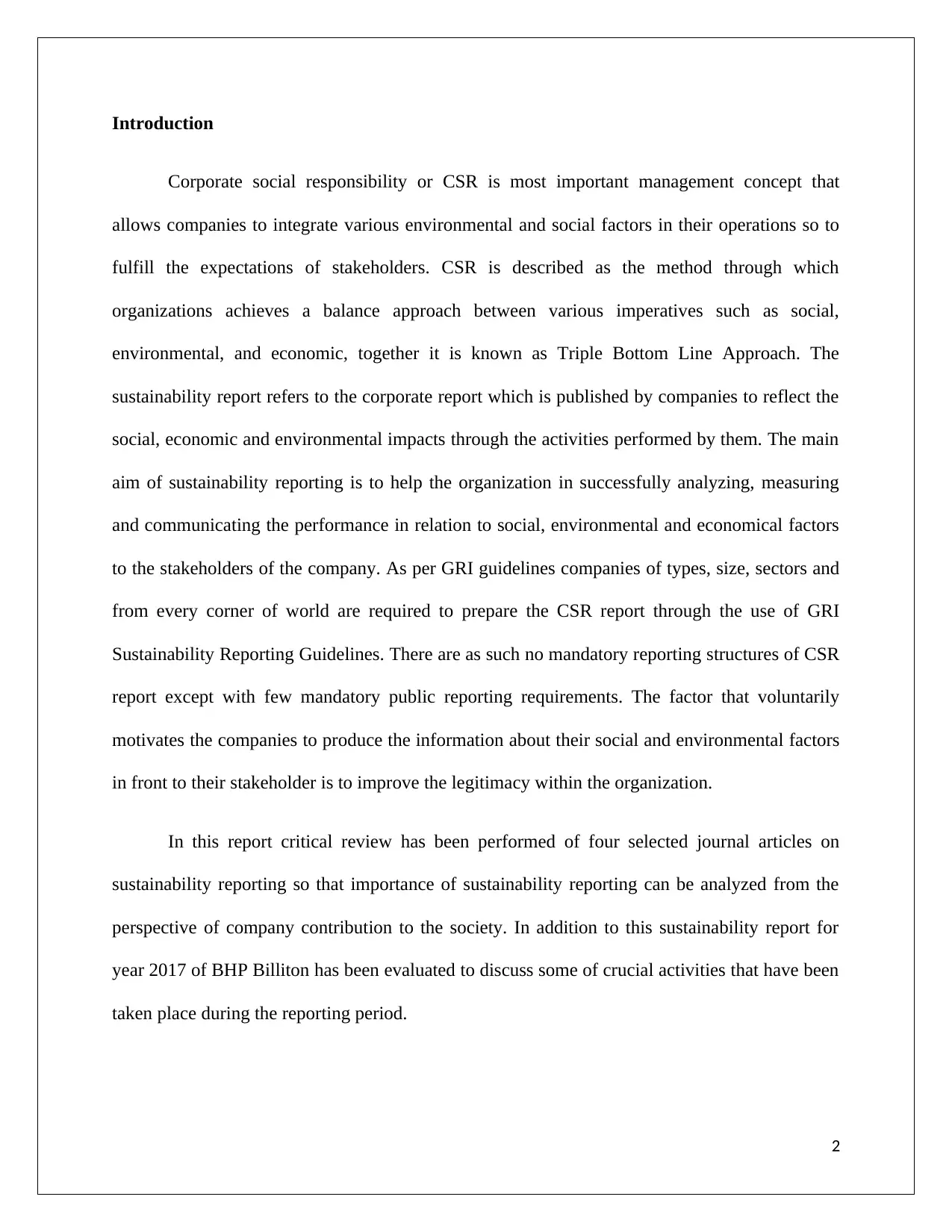
Introduction
Corporate social responsibility or CSR is most important management concept that
allows companies to integrate various environmental and social factors in their operations so to
fulfill the expectations of stakeholders. CSR is described as the method through which
organizations achieves a balance approach between various imperatives such as social,
environmental, and economic, together it is known as Triple Bottom Line Approach. The
sustainability report refers to the corporate report which is published by companies to reflect the
social, economic and environmental impacts through the activities performed by them. The main
aim of sustainability reporting is to help the organization in successfully analyzing, measuring
and communicating the performance in relation to social, environmental and economical factors
to the stakeholders of the company. As per GRI guidelines companies of types, size, sectors and
from every corner of world are required to prepare the CSR report through the use of GRI
Sustainability Reporting Guidelines. There are as such no mandatory reporting structures of CSR
report except with few mandatory public reporting requirements. The factor that voluntarily
motivates the companies to produce the information about their social and environmental factors
in front to their stakeholder is to improve the legitimacy within the organization.
In this report critical review has been performed of four selected journal articles on
sustainability reporting so that importance of sustainability reporting can be analyzed from the
perspective of company contribution to the society. In addition to this sustainability report for
year 2017 of BHP Billiton has been evaluated to discuss some of crucial activities that have been
taken place during the reporting period.
2
Corporate social responsibility or CSR is most important management concept that
allows companies to integrate various environmental and social factors in their operations so to
fulfill the expectations of stakeholders. CSR is described as the method through which
organizations achieves a balance approach between various imperatives such as social,
environmental, and economic, together it is known as Triple Bottom Line Approach. The
sustainability report refers to the corporate report which is published by companies to reflect the
social, economic and environmental impacts through the activities performed by them. The main
aim of sustainability reporting is to help the organization in successfully analyzing, measuring
and communicating the performance in relation to social, environmental and economical factors
to the stakeholders of the company. As per GRI guidelines companies of types, size, sectors and
from every corner of world are required to prepare the CSR report through the use of GRI
Sustainability Reporting Guidelines. There are as such no mandatory reporting structures of CSR
report except with few mandatory public reporting requirements. The factor that voluntarily
motivates the companies to produce the information about their social and environmental factors
in front to their stakeholder is to improve the legitimacy within the organization.
In this report critical review has been performed of four selected journal articles on
sustainability reporting so that importance of sustainability reporting can be analyzed from the
perspective of company contribution to the society. In addition to this sustainability report for
year 2017 of BHP Billiton has been evaluated to discuss some of crucial activities that have been
taken place during the reporting period.
2
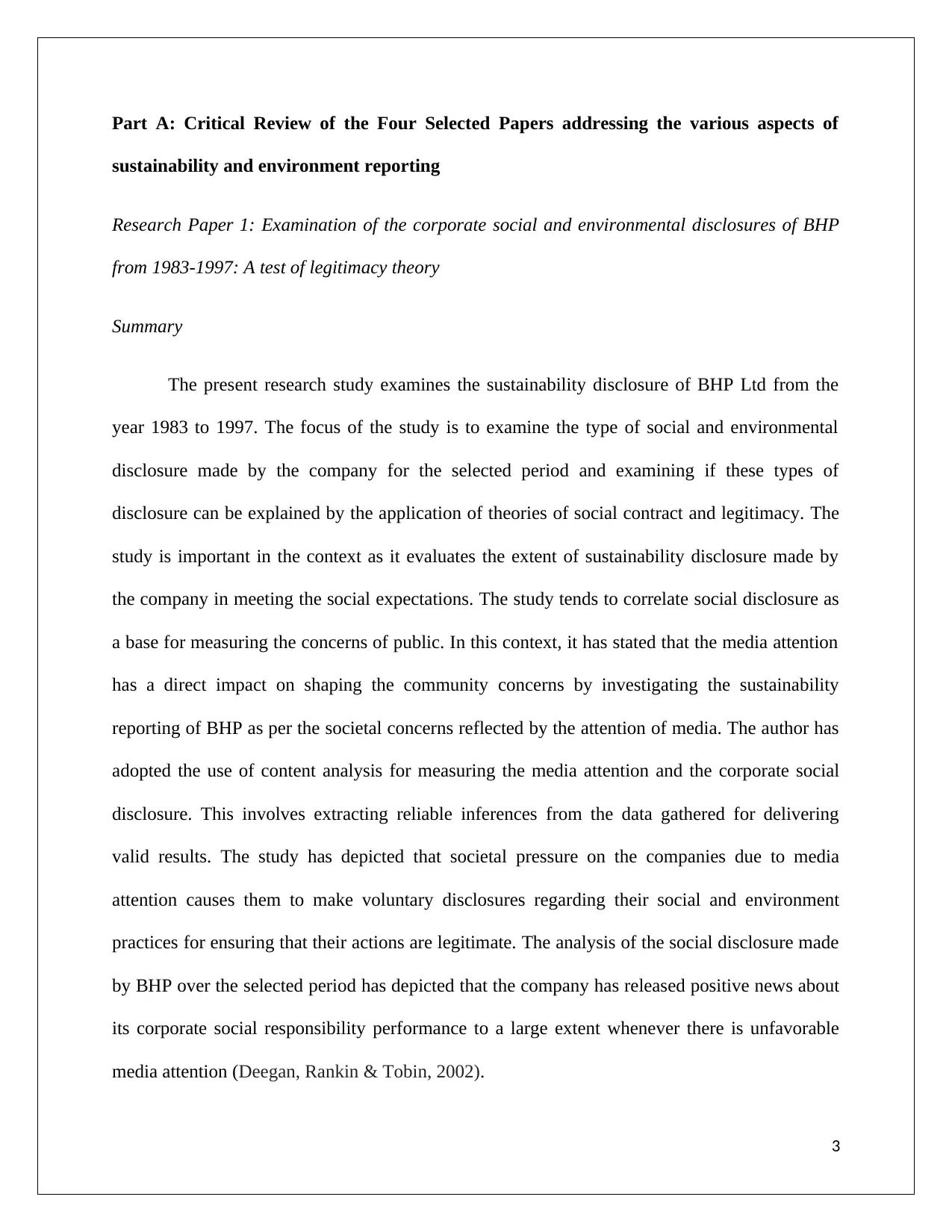
Part A: Critical Review of the Four Selected Papers addressing the various aspects of
sustainability and environment reporting
Research Paper 1: Examination of the corporate social and environmental disclosures of BHP
from 1983-1997: A test of legitimacy theory
Summary
The present research study examines the sustainability disclosure of BHP Ltd from the
year 1983 to 1997. The focus of the study is to examine the type of social and environmental
disclosure made by the company for the selected period and examining if these types of
disclosure can be explained by the application of theories of social contract and legitimacy. The
study is important in the context as it evaluates the extent of sustainability disclosure made by
the company in meeting the social expectations. The study tends to correlate social disclosure as
a base for measuring the concerns of public. In this context, it has stated that the media attention
has a direct impact on shaping the community concerns by investigating the sustainability
reporting of BHP as per the societal concerns reflected by the attention of media. The author has
adopted the use of content analysis for measuring the media attention and the corporate social
disclosure. This involves extracting reliable inferences from the data gathered for delivering
valid results. The study has depicted that societal pressure on the companies due to media
attention causes them to make voluntary disclosures regarding their social and environment
practices for ensuring that their actions are legitimate. The analysis of the social disclosure made
by BHP over the selected period has depicted that the company has released positive news about
its corporate social responsibility performance to a large extent whenever there is unfavorable
media attention (Deegan, Rankin & Tobin, 2002).
3
sustainability and environment reporting
Research Paper 1: Examination of the corporate social and environmental disclosures of BHP
from 1983-1997: A test of legitimacy theory
Summary
The present research study examines the sustainability disclosure of BHP Ltd from the
year 1983 to 1997. The focus of the study is to examine the type of social and environmental
disclosure made by the company for the selected period and examining if these types of
disclosure can be explained by the application of theories of social contract and legitimacy. The
study is important in the context as it evaluates the extent of sustainability disclosure made by
the company in meeting the social expectations. The study tends to correlate social disclosure as
a base for measuring the concerns of public. In this context, it has stated that the media attention
has a direct impact on shaping the community concerns by investigating the sustainability
reporting of BHP as per the societal concerns reflected by the attention of media. The author has
adopted the use of content analysis for measuring the media attention and the corporate social
disclosure. This involves extracting reliable inferences from the data gathered for delivering
valid results. The study has depicted that societal pressure on the companies due to media
attention causes them to make voluntary disclosures regarding their social and environment
practices for ensuring that their actions are legitimate. The analysis of the social disclosure made
by BHP over the selected period has depicted that the company has released positive news about
its corporate social responsibility performance to a large extent whenever there is unfavorable
media attention (Deegan, Rankin & Tobin, 2002).
3
⊘ This is a preview!⊘
Do you want full access?
Subscribe today to unlock all pages.

Trusted by 1+ million students worldwide
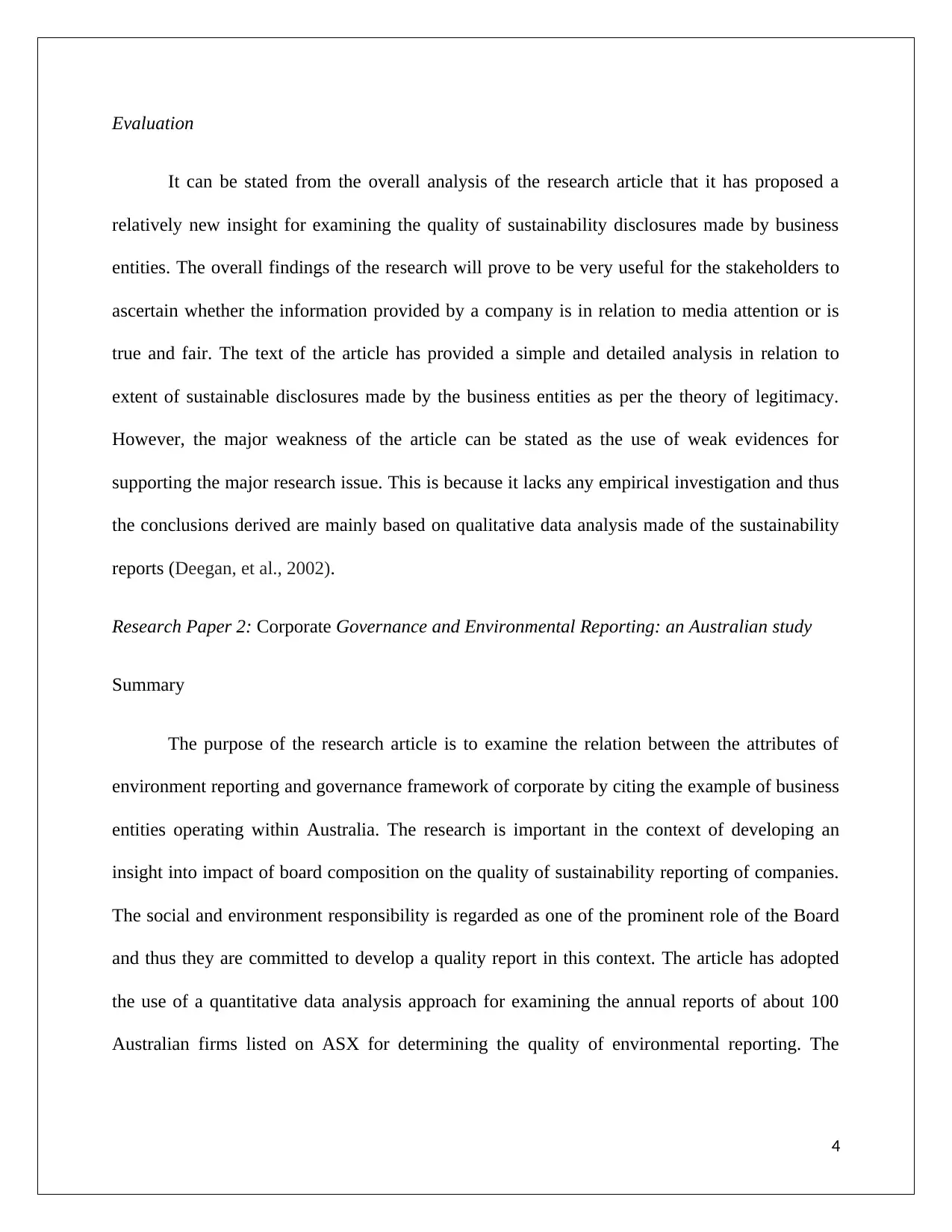
Evaluation
It can be stated from the overall analysis of the research article that it has proposed a
relatively new insight for examining the quality of sustainability disclosures made by business
entities. The overall findings of the research will prove to be very useful for the stakeholders to
ascertain whether the information provided by a company is in relation to media attention or is
true and fair. The text of the article has provided a simple and detailed analysis in relation to
extent of sustainable disclosures made by the business entities as per the theory of legitimacy.
However, the major weakness of the article can be stated as the use of weak evidences for
supporting the major research issue. This is because it lacks any empirical investigation and thus
the conclusions derived are mainly based on qualitative data analysis made of the sustainability
reports (Deegan, et al., 2002).
Research Paper 2: Corporate Governance and Environmental Reporting: an Australian study
Summary
The purpose of the research article is to examine the relation between the attributes of
environment reporting and governance framework of corporate by citing the example of business
entities operating within Australia. The research is important in the context of developing an
insight into impact of board composition on the quality of sustainability reporting of companies.
The social and environment responsibility is regarded as one of the prominent role of the Board
and thus they are committed to develop a quality report in this context. The article has adopted
the use of a quantitative data analysis approach for examining the annual reports of about 100
Australian firms listed on ASX for determining the quality of environmental reporting. The
4
It can be stated from the overall analysis of the research article that it has proposed a
relatively new insight for examining the quality of sustainability disclosures made by business
entities. The overall findings of the research will prove to be very useful for the stakeholders to
ascertain whether the information provided by a company is in relation to media attention or is
true and fair. The text of the article has provided a simple and detailed analysis in relation to
extent of sustainable disclosures made by the business entities as per the theory of legitimacy.
However, the major weakness of the article can be stated as the use of weak evidences for
supporting the major research issue. This is because it lacks any empirical investigation and thus
the conclusions derived are mainly based on qualitative data analysis made of the sustainability
reports (Deegan, et al., 2002).
Research Paper 2: Corporate Governance and Environmental Reporting: an Australian study
Summary
The purpose of the research article is to examine the relation between the attributes of
environment reporting and governance framework of corporate by citing the example of business
entities operating within Australia. The research is important in the context of developing an
insight into impact of board composition on the quality of sustainability reporting of companies.
The social and environment responsibility is regarded as one of the prominent role of the Board
and thus they are committed to develop a quality report in this context. The article has adopted
the use of a quantitative data analysis approach for examining the annual reports of about 100
Australian firms listed on ASX for determining the quality of environmental reporting. The
4
Paraphrase This Document
Need a fresh take? Get an instant paraphrase of this document with our AI Paraphraser
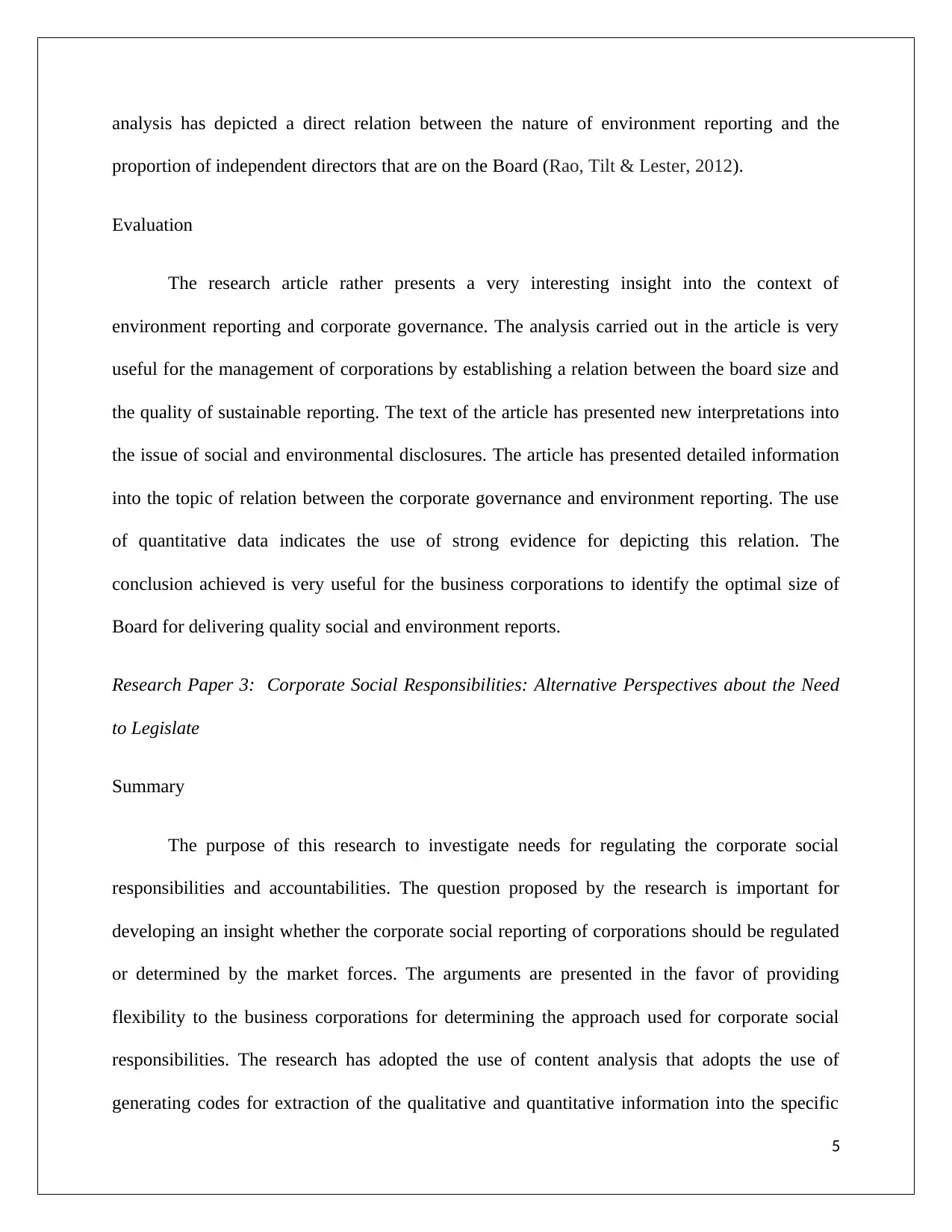
analysis has depicted a direct relation between the nature of environment reporting and the
proportion of independent directors that are on the Board (Rao, Tilt & Lester, 2012).
Evaluation
The research article rather presents a very interesting insight into the context of
environment reporting and corporate governance. The analysis carried out in the article is very
useful for the management of corporations by establishing a relation between the board size and
the quality of sustainable reporting. The text of the article has presented new interpretations into
the issue of social and environmental disclosures. The article has presented detailed information
into the topic of relation between the corporate governance and environment reporting. The use
of quantitative data indicates the use of strong evidence for depicting this relation. The
conclusion achieved is very useful for the business corporations to identify the optimal size of
Board for delivering quality social and environment reports.
Research Paper 3: Corporate Social Responsibilities: Alternative Perspectives about the Need
to Legislate
Summary
The purpose of this research to investigate needs for regulating the corporate social
responsibilities and accountabilities. The question proposed by the research is important for
developing an insight whether the corporate social reporting of corporations should be regulated
or determined by the market forces. The arguments are presented in the favor of providing
flexibility to the business corporations for determining the approach used for corporate social
responsibilities. The research has adopted the use of content analysis that adopts the use of
generating codes for extraction of the qualitative and quantitative information into the specific
5
proportion of independent directors that are on the Board (Rao, Tilt & Lester, 2012).
Evaluation
The research article rather presents a very interesting insight into the context of
environment reporting and corporate governance. The analysis carried out in the article is very
useful for the management of corporations by establishing a relation between the board size and
the quality of sustainable reporting. The text of the article has presented new interpretations into
the issue of social and environmental disclosures. The article has presented detailed information
into the topic of relation between the corporate governance and environment reporting. The use
of quantitative data indicates the use of strong evidence for depicting this relation. The
conclusion achieved is very useful for the business corporations to identify the optimal size of
Board for delivering quality social and environment reports.
Research Paper 3: Corporate Social Responsibilities: Alternative Perspectives about the Need
to Legislate
Summary
The purpose of this research to investigate needs for regulating the corporate social
responsibilities and accountabilities. The question proposed by the research is important for
developing an insight whether the corporate social reporting of corporations should be regulated
or determined by the market forces. The arguments are presented in the favor of providing
flexibility to the business corporations for determining the approach used for corporate social
responsibilities. The research has adopted the use of content analysis that adopts the use of
generating codes for extraction of the qualitative and quantitative information into the specific
5
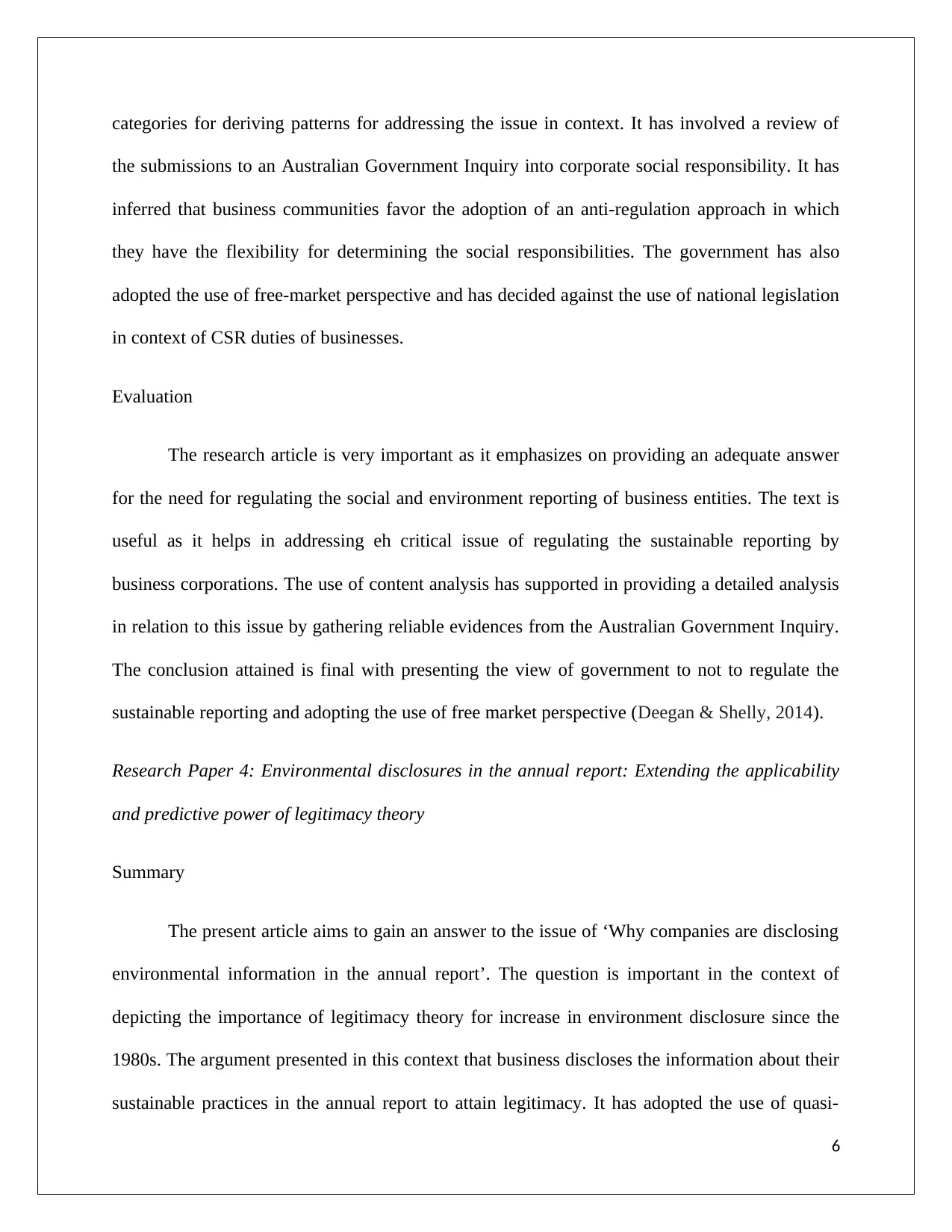
categories for deriving patterns for addressing the issue in context. It has involved a review of
the submissions to an Australian Government Inquiry into corporate social responsibility. It has
inferred that business communities favor the adoption of an anti-regulation approach in which
they have the flexibility for determining the social responsibilities. The government has also
adopted the use of free-market perspective and has decided against the use of national legislation
in context of CSR duties of businesses.
Evaluation
The research article is very important as it emphasizes on providing an adequate answer
for the need for regulating the social and environment reporting of business entities. The text is
useful as it helps in addressing eh critical issue of regulating the sustainable reporting by
business corporations. The use of content analysis has supported in providing a detailed analysis
in relation to this issue by gathering reliable evidences from the Australian Government Inquiry.
The conclusion attained is final with presenting the view of government to not to regulate the
sustainable reporting and adopting the use of free market perspective (Deegan & Shelly, 2014).
Research Paper 4: Environmental disclosures in the annual report: Extending the applicability
and predictive power of legitimacy theory
Summary
The present article aims to gain an answer to the issue of ‘Why companies are disclosing
environmental information in the annual report’. The question is important in the context of
depicting the importance of legitimacy theory for increase in environment disclosure since the
1980s. The argument presented in this context that business discloses the information about their
sustainable practices in the annual report to attain legitimacy. It has adopted the use of quasi-
6
the submissions to an Australian Government Inquiry into corporate social responsibility. It has
inferred that business communities favor the adoption of an anti-regulation approach in which
they have the flexibility for determining the social responsibilities. The government has also
adopted the use of free-market perspective and has decided against the use of national legislation
in context of CSR duties of businesses.
Evaluation
The research article is very important as it emphasizes on providing an adequate answer
for the need for regulating the social and environment reporting of business entities. The text is
useful as it helps in addressing eh critical issue of regulating the sustainable reporting by
business corporations. The use of content analysis has supported in providing a detailed analysis
in relation to this issue by gathering reliable evidences from the Australian Government Inquiry.
The conclusion attained is final with presenting the view of government to not to regulate the
sustainable reporting and adopting the use of free market perspective (Deegan & Shelly, 2014).
Research Paper 4: Environmental disclosures in the annual report: Extending the applicability
and predictive power of legitimacy theory
Summary
The present article aims to gain an answer to the issue of ‘Why companies are disclosing
environmental information in the annual report’. The question is important in the context of
depicting the importance of legitimacy theory for increase in environment disclosure since the
1980s. The argument presented in this context that business discloses the information about their
sustainable practices in the annual report to attain legitimacy. It has adopted the use of quasi-
6
⊘ This is a preview!⊘
Do you want full access?
Subscribe today to unlock all pages.

Trusted by 1+ million students worldwide
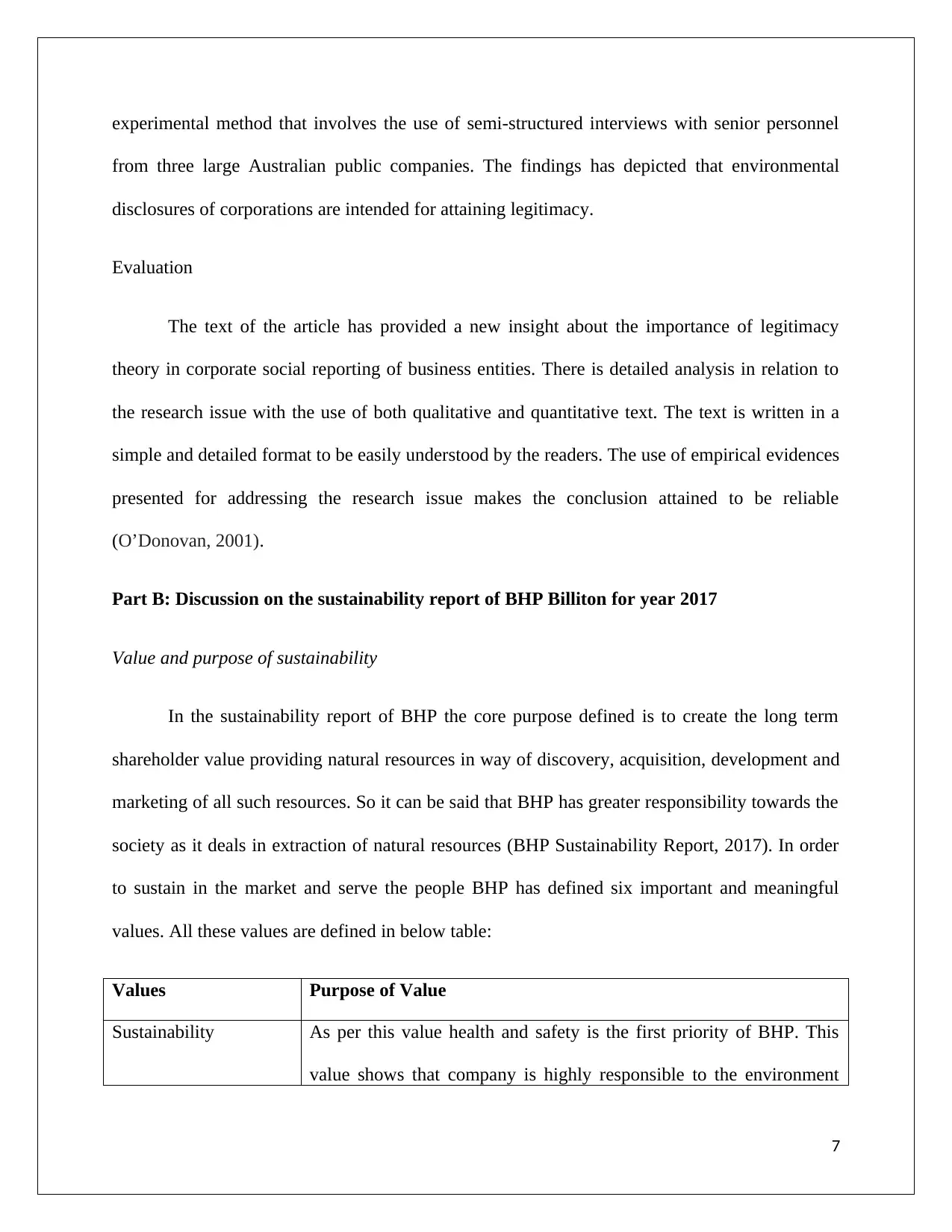
experimental method that involves the use of semi-structured interviews with senior personnel
from three large Australian public companies. The findings has depicted that environmental
disclosures of corporations are intended for attaining legitimacy.
Evaluation
The text of the article has provided a new insight about the importance of legitimacy
theory in corporate social reporting of business entities. There is detailed analysis in relation to
the research issue with the use of both qualitative and quantitative text. The text is written in a
simple and detailed format to be easily understood by the readers. The use of empirical evidences
presented for addressing the research issue makes the conclusion attained to be reliable
(O’Donovan, 2001).
Part B: Discussion on the sustainability report of BHP Billiton for year 2017
Value and purpose of sustainability
In the sustainability report of BHP the core purpose defined is to create the long term
shareholder value providing natural resources in way of discovery, acquisition, development and
marketing of all such resources. So it can be said that BHP has greater responsibility towards the
society as it deals in extraction of natural resources (BHP Sustainability Report, 2017). In order
to sustain in the market and serve the people BHP has defined six important and meaningful
values. All these values are defined in below table:
Values Purpose of Value
Sustainability As per this value health and safety is the first priority of BHP. This
value shows that company is highly responsible to the environment
7
from three large Australian public companies. The findings has depicted that environmental
disclosures of corporations are intended for attaining legitimacy.
Evaluation
The text of the article has provided a new insight about the importance of legitimacy
theory in corporate social reporting of business entities. There is detailed analysis in relation to
the research issue with the use of both qualitative and quantitative text. The text is written in a
simple and detailed format to be easily understood by the readers. The use of empirical evidences
presented for addressing the research issue makes the conclusion attained to be reliable
(O’Donovan, 2001).
Part B: Discussion on the sustainability report of BHP Billiton for year 2017
Value and purpose of sustainability
In the sustainability report of BHP the core purpose defined is to create the long term
shareholder value providing natural resources in way of discovery, acquisition, development and
marketing of all such resources. So it can be said that BHP has greater responsibility towards the
society as it deals in extraction of natural resources (BHP Sustainability Report, 2017). In order
to sustain in the market and serve the people BHP has defined six important and meaningful
values. All these values are defined in below table:
Values Purpose of Value
Sustainability As per this value health and safety is the first priority of BHP. This
value shows that company is highly responsible to the environment
7
Paraphrase This Document
Need a fresh take? Get an instant paraphrase of this document with our AI Paraphraser
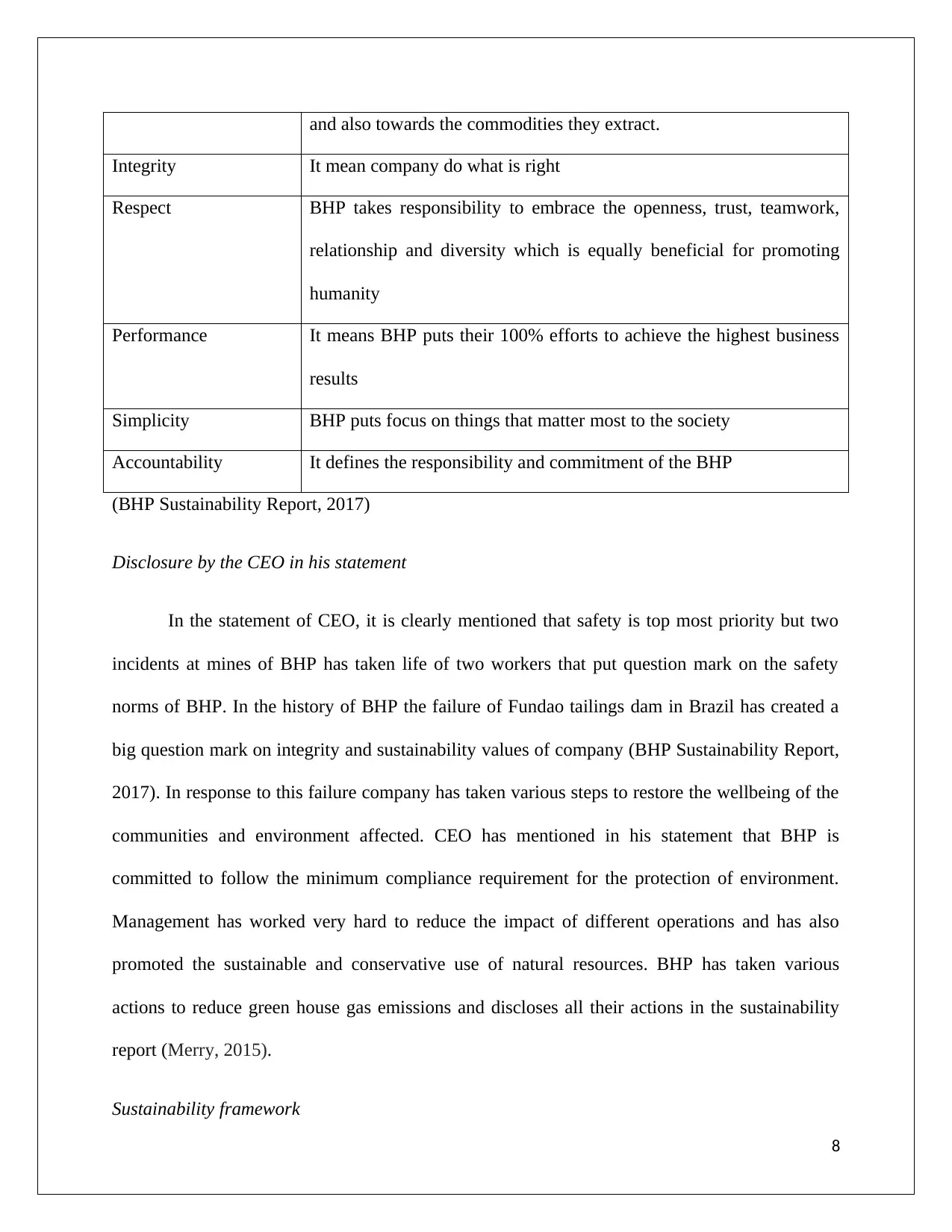
and also towards the commodities they extract.
Integrity It mean company do what is right
Respect BHP takes responsibility to embrace the openness, trust, teamwork,
relationship and diversity which is equally beneficial for promoting
humanity
Performance It means BHP puts their 100% efforts to achieve the highest business
results
Simplicity BHP puts focus on things that matter most to the society
Accountability It defines the responsibility and commitment of the BHP
(BHP Sustainability Report, 2017)
Disclosure by the CEO in his statement
In the statement of CEO, it is clearly mentioned that safety is top most priority but two
incidents at mines of BHP has taken life of two workers that put question mark on the safety
norms of BHP. In the history of BHP the failure of Fundao tailings dam in Brazil has created a
big question mark on integrity and sustainability values of company (BHP Sustainability Report,
2017). In response to this failure company has taken various steps to restore the wellbeing of the
communities and environment affected. CEO has mentioned in his statement that BHP is
committed to follow the minimum compliance requirement for the protection of environment.
Management has worked very hard to reduce the impact of different operations and has also
promoted the sustainable and conservative use of natural resources. BHP has taken various
actions to reduce green house gas emissions and discloses all their actions in the sustainability
report (Merry, 2015).
Sustainability framework
8
Integrity It mean company do what is right
Respect BHP takes responsibility to embrace the openness, trust, teamwork,
relationship and diversity which is equally beneficial for promoting
humanity
Performance It means BHP puts their 100% efforts to achieve the highest business
results
Simplicity BHP puts focus on things that matter most to the society
Accountability It defines the responsibility and commitment of the BHP
(BHP Sustainability Report, 2017)
Disclosure by the CEO in his statement
In the statement of CEO, it is clearly mentioned that safety is top most priority but two
incidents at mines of BHP has taken life of two workers that put question mark on the safety
norms of BHP. In the history of BHP the failure of Fundao tailings dam in Brazil has created a
big question mark on integrity and sustainability values of company (BHP Sustainability Report,
2017). In response to this failure company has taken various steps to restore the wellbeing of the
communities and environment affected. CEO has mentioned in his statement that BHP is
committed to follow the minimum compliance requirement for the protection of environment.
Management has worked very hard to reduce the impact of different operations and has also
promoted the sustainable and conservative use of natural resources. BHP has taken various
actions to reduce green house gas emissions and discloses all their actions in the sustainability
report (Merry, 2015).
Sustainability framework
8
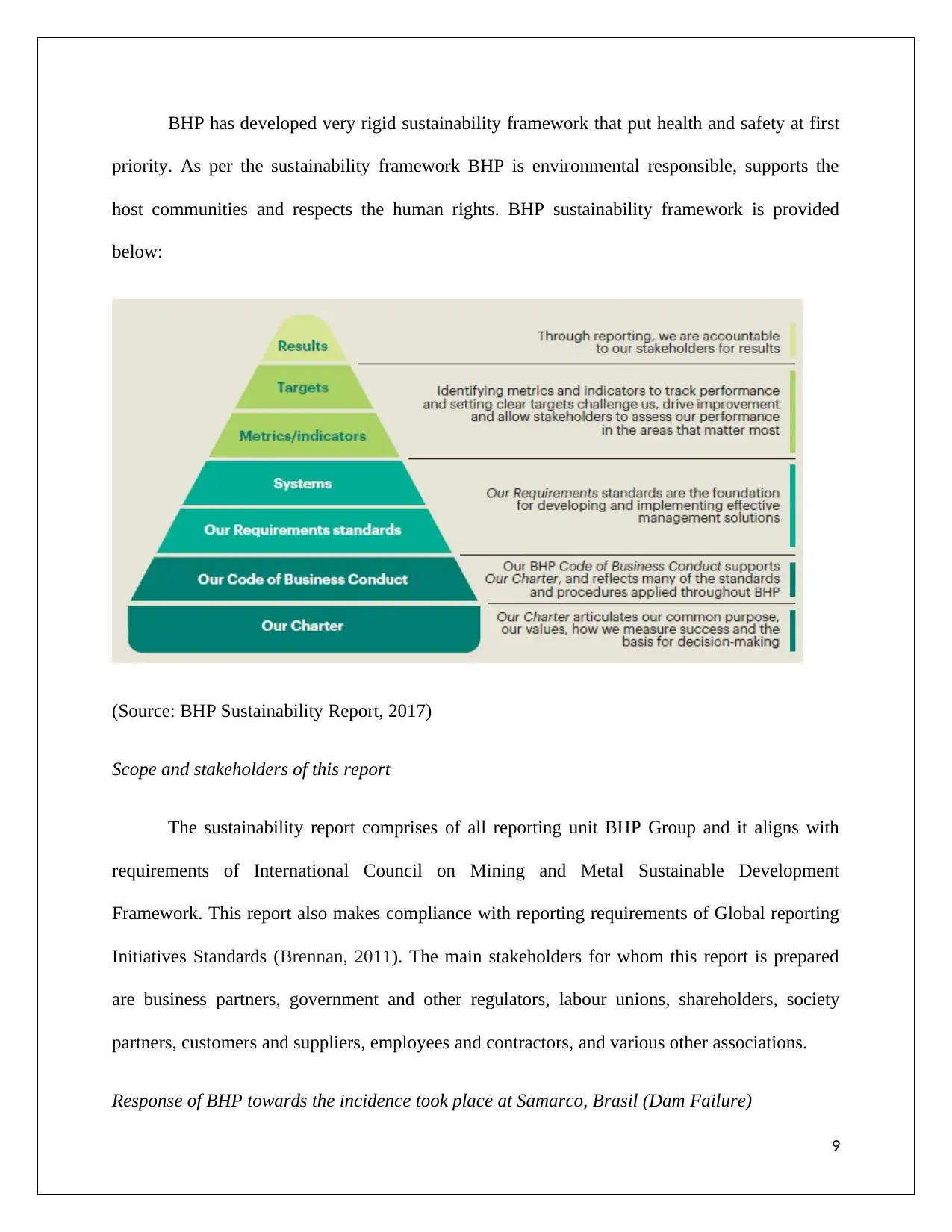
BHP has developed very rigid sustainability framework that put health and safety at first
priority. As per the sustainability framework BHP is environmental responsible, supports the
host communities and respects the human rights. BHP sustainability framework is provided
below:
(Source: BHP Sustainability Report, 2017)
Scope and stakeholders of this report
The sustainability report comprises of all reporting unit BHP Group and it aligns with
requirements of International Council on Mining and Metal Sustainable Development
Framework. This report also makes compliance with reporting requirements of Global reporting
Initiatives Standards (Brennan, 2011). The main stakeholders for whom this report is prepared
are business partners, government and other regulators, labour unions, shareholders, society
partners, customers and suppliers, employees and contractors, and various other associations.
Response of BHP towards the incidence took place at Samarco, Brasil (Dam Failure)
9
priority. As per the sustainability framework BHP is environmental responsible, supports the
host communities and respects the human rights. BHP sustainability framework is provided
below:
(Source: BHP Sustainability Report, 2017)
Scope and stakeholders of this report
The sustainability report comprises of all reporting unit BHP Group and it aligns with
requirements of International Council on Mining and Metal Sustainable Development
Framework. This report also makes compliance with reporting requirements of Global reporting
Initiatives Standards (Brennan, 2011). The main stakeholders for whom this report is prepared
are business partners, government and other regulators, labour unions, shareholders, society
partners, customers and suppliers, employees and contractors, and various other associations.
Response of BHP towards the incidence took place at Samarco, Brasil (Dam Failure)
9
⊘ This is a preview!⊘
Do you want full access?
Subscribe today to unlock all pages.

Trusted by 1+ million students worldwide
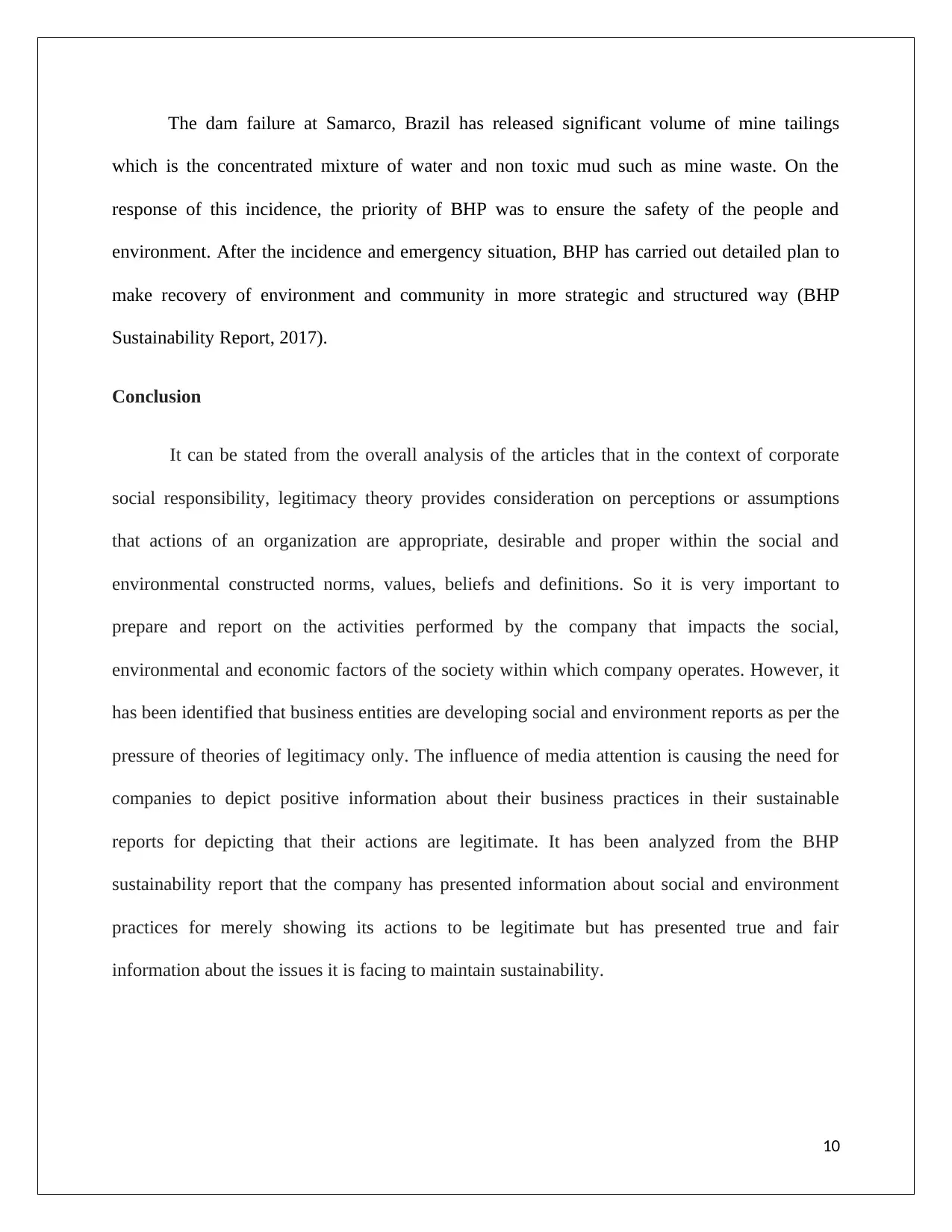
The dam failure at Samarco, Brazil has released significant volume of mine tailings
which is the concentrated mixture of water and non toxic mud such as mine waste. On the
response of this incidence, the priority of BHP was to ensure the safety of the people and
environment. After the incidence and emergency situation, BHP has carried out detailed plan to
make recovery of environment and community in more strategic and structured way (BHP
Sustainability Report, 2017).
Conclusion
It can be stated from the overall analysis of the articles that in the context of corporate
social responsibility, legitimacy theory provides consideration on perceptions or assumptions
that actions of an organization are appropriate, desirable and proper within the social and
environmental constructed norms, values, beliefs and definitions. So it is very important to
prepare and report on the activities performed by the company that impacts the social,
environmental and economic factors of the society within which company operates. However, it
has been identified that business entities are developing social and environment reports as per the
pressure of theories of legitimacy only. The influence of media attention is causing the need for
companies to depict positive information about their business practices in their sustainable
reports for depicting that their actions are legitimate. It has been analyzed from the BHP
sustainability report that the company has presented information about social and environment
practices for merely showing its actions to be legitimate but has presented true and fair
information about the issues it is facing to maintain sustainability.
10
which is the concentrated mixture of water and non toxic mud such as mine waste. On the
response of this incidence, the priority of BHP was to ensure the safety of the people and
environment. After the incidence and emergency situation, BHP has carried out detailed plan to
make recovery of environment and community in more strategic and structured way (BHP
Sustainability Report, 2017).
Conclusion
It can be stated from the overall analysis of the articles that in the context of corporate
social responsibility, legitimacy theory provides consideration on perceptions or assumptions
that actions of an organization are appropriate, desirable and proper within the social and
environmental constructed norms, values, beliefs and definitions. So it is very important to
prepare and report on the activities performed by the company that impacts the social,
environmental and economic factors of the society within which company operates. However, it
has been identified that business entities are developing social and environment reports as per the
pressure of theories of legitimacy only. The influence of media attention is causing the need for
companies to depict positive information about their business practices in their sustainable
reports for depicting that their actions are legitimate. It has been analyzed from the BHP
sustainability report that the company has presented information about social and environment
practices for merely showing its actions to be legitimate but has presented true and fair
information about the issues it is facing to maintain sustainability.
10
Paraphrase This Document
Need a fresh take? Get an instant paraphrase of this document with our AI Paraphraser
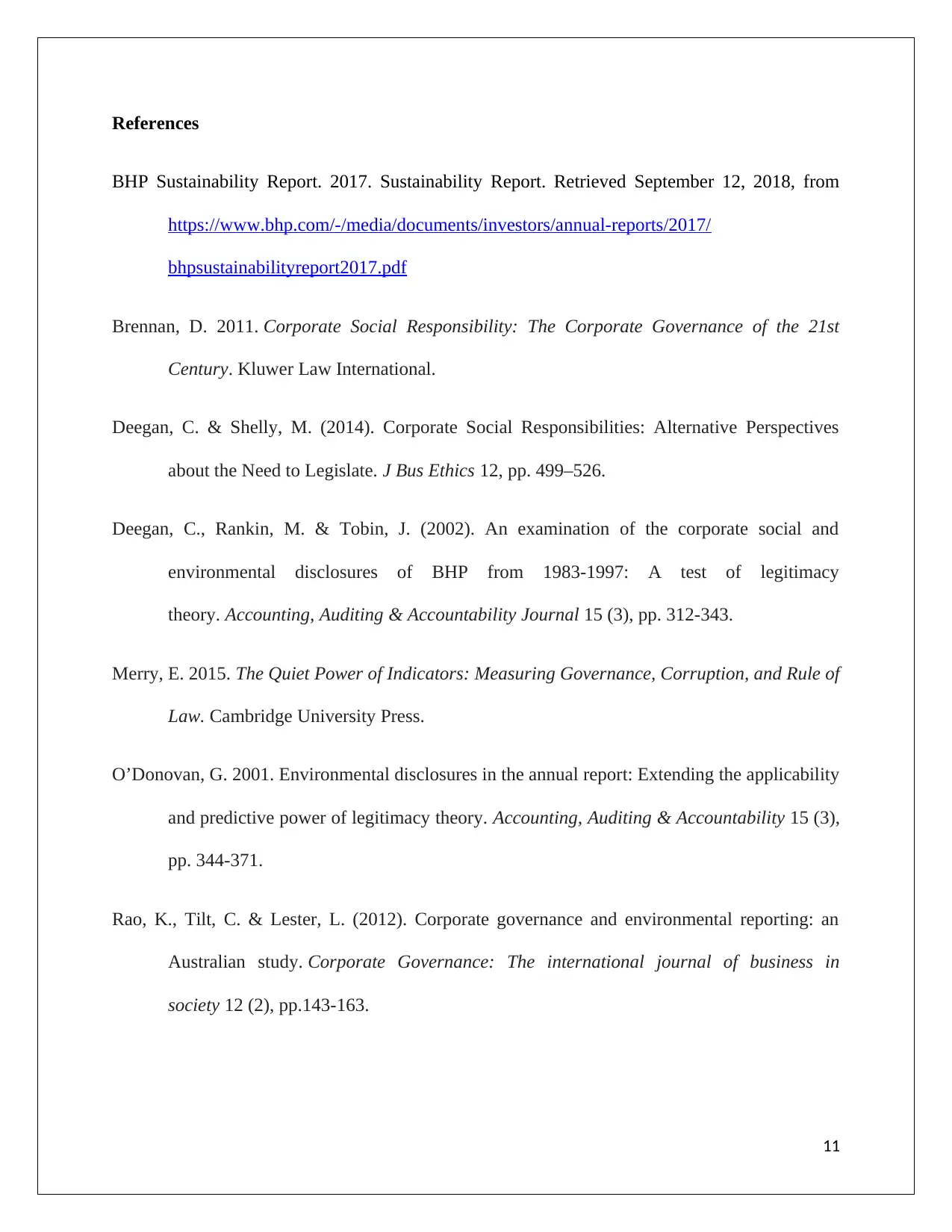
References
BHP Sustainability Report. 2017. Sustainability Report. Retrieved September 12, 2018, from
https://www.bhp.com/-/media/documents/investors/annual-reports/2017/
bhpsustainabilityreport2017.pdf
Brennan, D. 2011. Corporate Social Responsibility: The Corporate Governance of the 21st
Century. Kluwer Law International.
Deegan, C. & Shelly, M. (2014). Corporate Social Responsibilities: Alternative Perspectives
about the Need to Legislate. J Bus Ethics 12, pp. 499–526.
Deegan, C., Rankin, M. & Tobin, J. (2002). An examination of the corporate social and
environmental disclosures of BHP from 1983‐1997: A test of legitimacy
theory. Accounting, Auditing & Accountability Journal 15 (3), pp. 312-343.
Merry, E. 2015. The Quiet Power of Indicators: Measuring Governance, Corruption, and Rule of
Law. Cambridge University Press.
O’Donovan, G. 2001. Environmental disclosures in the annual report: Extending the applicability
and predictive power of legitimacy theory. Accounting, Auditing & Accountability 15 (3),
pp. 344-371.
Rao, K., Tilt, C. & Lester, L. (2012). Corporate governance and environmental reporting: an
Australian study. Corporate Governance: The international journal of business in
society 12 (2), pp.143-163.
11
BHP Sustainability Report. 2017. Sustainability Report. Retrieved September 12, 2018, from
https://www.bhp.com/-/media/documents/investors/annual-reports/2017/
bhpsustainabilityreport2017.pdf
Brennan, D. 2011. Corporate Social Responsibility: The Corporate Governance of the 21st
Century. Kluwer Law International.
Deegan, C. & Shelly, M. (2014). Corporate Social Responsibilities: Alternative Perspectives
about the Need to Legislate. J Bus Ethics 12, pp. 499–526.
Deegan, C., Rankin, M. & Tobin, J. (2002). An examination of the corporate social and
environmental disclosures of BHP from 1983‐1997: A test of legitimacy
theory. Accounting, Auditing & Accountability Journal 15 (3), pp. 312-343.
Merry, E. 2015. The Quiet Power of Indicators: Measuring Governance, Corruption, and Rule of
Law. Cambridge University Press.
O’Donovan, G. 2001. Environmental disclosures in the annual report: Extending the applicability
and predictive power of legitimacy theory. Accounting, Auditing & Accountability 15 (3),
pp. 344-371.
Rao, K., Tilt, C. & Lester, L. (2012). Corporate governance and environmental reporting: an
Australian study. Corporate Governance: The international journal of business in
society 12 (2), pp.143-163.
11
1 out of 11
Related Documents
Your All-in-One AI-Powered Toolkit for Academic Success.
+13062052269
info@desklib.com
Available 24*7 on WhatsApp / Email
![[object Object]](/_next/static/media/star-bottom.7253800d.svg)
Unlock your academic potential
Copyright © 2020–2025 A2Z Services. All Rights Reserved. Developed and managed by ZUCOL.





